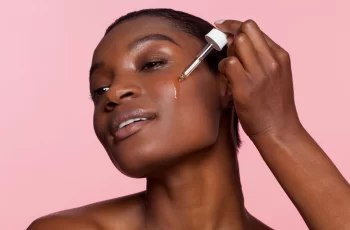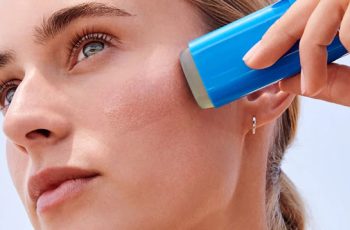
Can You Use Niacinamide on Open Spots?
In recent years, niacinamide has gained an impressive amount of popularity. An established favourite amongst skincare experts and fans combined, niacinamide is a highly effective ingredient able to deliver an array of skin benefits.
With an increase of many of us suffering from frequent breakouts due to wearing masks and day to day stress on the skin. Niacinamide has been able to step in and work on perfecting the skin’s clarity as well as keeping it hydrated and protective skin barrier strengthened and functioning properly. If you are wondering what niacinamide can do for the skin, here is a quick recap on its benefits before we find out more about whether you can use niacinamide on open spots.
What is Niacinamide?
Niacinamide is a form of vitamin B3 and can naturally occur in the body thanks to the amino acids found in some forms of protein. When formulated into skincare products, niacinamide can deliver hydrating skin results. Fine lines and wrinkles are notably reduced, and the complexion is plumped with a youthful bounce. It can prevent further skin damage caused from exposure to free radicals by keeping the skin barrier healthy and strong.
Niacinamide is known for acting in a similar way on the skin as hyaluronic acid but has its own unique trait. It can regulate the production of sebum in the skin helping to reduce the frequency of breakouts and minimise the appearance of pores making it a beneficial ingredient for those with an oily and blemish-prone skin type. It is one ingredient that can be introduced into a routine in an easy and effective way, but always ensure you have consulted with a doctor or dermatologist beforehand. If you wanted to know more about niacinamide, check out our dedicated blog post about how to use the ingredient on your face.
Now, let’s dive in and find out more about using niacinamide on open spots.
Can you put niacinamide on spots?
Yes, you certainly can! Niacinamide is a highly effective, yet gentle ingredient to use on the skin. Favoured by many, especially if prone to frequent blemishes as the humectant ingredient can regulate sebum production. Quite often those who suffer from regular breakouts may tend to opt for ingredients that can sometimes be too potent for the skin. This will lead to the skin overproducing sebum resulting in more blemishes and a vicious cycle resulting in the protective barrier being weakened and pH levels becoming imbalanced.
You’ll find that apply topical formulations, such as serum enriched in niacinamide on the skin surface will keep the complexion plumped whilst reducing the size and redness of spots. You can continue to use these formulas once the complexion has cleared to help ward off any possible hyperpigmentation, or acne scarring left behind from acne and free radical exposure.
Can I put niacinamide on open wound?
Yes, absolutely you can apply niacinamide to open wounds. There have been several studies carried out that prove how effective the anti-inflammatory properties are on the skin. Niacinamide works at accelerating the speed of healing wounds by increasing proliferation and fibroblast migration, both of which are essential at healing wounds and speeding up how quickly they close on the surface.
Can I apply niacinamide on popped pimples?
Yes, you can apply niacinamide on popped pimples. The only concern is, the pimple shouldn’t have been popped in the first place, but we understand you’re only human. So, here is an example of how to treat a popped pimple ensuring it doesn’t snowball into an influx of problematic skin. Here is what you should do after popping a pimple.
Ensure you wash your hands thoroughly with warm water and antibacterial handwash.
Dab the pimple with clean cotton bud absorbing any remaining blood, liquid.
To prevent the area from becoming infected, swipe a cotton disc soaked in a glycolic acid or salicylic enriched toner.
Next apply an overnight spot treatment directly onto the popped pimple to coat the area preventing bacteria from getting into the area.
Continue applying the rest of your evening skincare routine avoiding the infected area.
Once you’ve woken up in the morning wash your face with a cleanser containing low percentage of salicylic acid, follow this with serum enriched in vitamin C, wait for 15 minutes then follow this with another serum containing niacinamide.
Finish off your routine with a daily SPF of 30 and above for full protection from UV exposure and other free radicals.
Everyone’s skin is different; therefore, it is important to consult with a doctor or dermatologist to ensure you and your skin will remain happy introducing niacinamide into your daily routine.
Can niacinamide cause breakouts?
Not really, this is because niacinamide does not work on the skin in a way that can cause breakouts or purging. When a skin ingredient increases the speed of cell turnover, you’ll find you suffer from more breakouts before the skin gains more clarity. Because niacinamide delivers hydration to the skin and doesn’t exfoliate it is unlikely this ingredient will cause purging or breakouts.
What you will find is teaming niacinamide with an exfoliant, such as glycolic acid or salicylic acid, any sign of irritation, purging, dryness, redness, or discomfort will be counteracted.
Is niacinamide good for acne scars?
Yes, niacinamide is a great ingredient to use to target acne scars. With its antioxidant and anti-inflammatory benefits, it can help prevent any existing acne scars from remaining on the skin. When niacinamide is applied to the skin it will work at reducing the pigmentation of dark spots and acne scars whilst reducing any inflammations caused from active blemishes. You will also find teaming niacinamide with acne fighting ingredients, such as the BHA, salicylic acid, the skin will remain healthy, balanced, and easier to maintain.
There you have a little more information about using niacinamide on open spots, don’t forget if you have any further questions, come, and follow us on Instagram. You’ll find one of our skincare experts in our direct messages.


